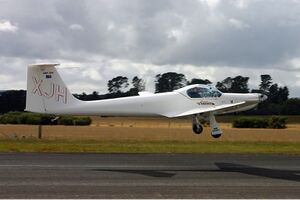Engineering:Aeromot AMT-200 Super Ximango
From HandWiki
| AMT-200 Super Ximango | |
|---|---|

| |
| Role | Motor glider |
| National origin | Brazil |
| Manufacturer | Aeromot |
| Designer | René Fournier |
| Introduction | 1993 |
| Number built | 126 (2009) |
| Developed from | AMT-100 Ximango |
The Aeromot AMT-200 Super Ximango is a Brazilian motor glider developed from the AMT-100 Ximango but fitted with a Rotax 912 engine.[1]
Design and development
Built from glassfibre, the Super Ximango is a low-wing cantilever monoplane with conventional landing gear and a T-tail. Powered by front-mounted 80 hp Rotax 912A, it has an enclosed side-by-side cockpit for two. The wings fold for storage or transportation.
Variants
- AMT-200
- Rotax 912A powered variant in the Utility category.
- AMT-200S
- Rotax 912S4 powered variant in the Utility category.
- AMT-200SO
- Reconnaissance variant of the AMT-200S in the Restricted category
Operators
 United States
United States
- United States Air Force – operated by the U.S. Air Force Academy as the TG-14.
- NASA – operated at Armstrong Flight Research Center as the TG-14.
 Brazil
Brazil
- Military Police of Paraná State – operated in patrol of environmental policing.
 Dominican Republic
Dominican Republic
Specification
Data from Taylor 1996, p. 511, Jackson 2007, p. 28
General characteristics
- Crew: 2
- Length: 8.05 m (26 ft 5 in)
- Wingspan: 17.47 m (57 ft 4 in)
- Width: 10.15 m (33 ft 4 in)
- Height: 1.93 m (6 ft 4 in)
- Wing area: 18.7 m2 (201 sq ft)
- Aspect ratio: 16
- Airfoil: NACA 643-618
- Empty weight: 625 kg (1,378 lb)
- Max takeoff weight: 850 kg (1,874 lb)
- Fuel capacity: 90 L (24 US gal; 20 imp gal)
- Powerplant: 1 × Rotax 914-S4 piston engine, 60 kW (80 hp)
- Propellers: 2-bladed Hoffmann HO-V62R/170FA, 1.70 m (5 ft 7 in) diameter
Performance
- Maximum speed: 220 km/h (140 mph, 120 kn)
- Cruise speed: 205 km/h (127 mph, 111 kn)
- Stall speed: 76 km/h (47 mph, 41 kn)
- Never exceed speed: 245 km/h (152 mph, 132 kn)
- Range: 1,000 km (620 mi, 540 nmi)
- Service ceiling: 4,900 m (16,100 ft)
- Maximum glide ratio: 31
- Rate of climb: 1.8 m/s (350 ft/min)
- Rate of sink: .93 m/s (183 ft/min)
- Wing loading: 45.3 kg/m2 (9.3 lb/sq ft)
References
- ↑ Taylor 1996, p. 511.
Bibliography
- Taylor, Michael JH (1996), Brassey's World Aircraft & Systems Directory 1996/97, London: Brassey's, ISBN 1-85753-198-1, https://archive.org/details/brasseysworldair0000unse
- Jackson, Paul (2007). Jane's All The World's Aircraft 2007-2008. United Kingdom: Jane's Information Group. ISBN 9780710627926..
External links
- (in Portuguese) Certificação, Brazil: Anac, archived from the original on 2011-07-06, https://web.archive.org/web/20110706160237/http://www.anac.gov.br/certificacao/Produtos/Espec/EP-8602-15i.pdf.
 |


